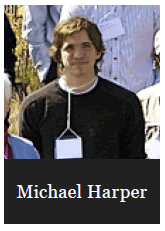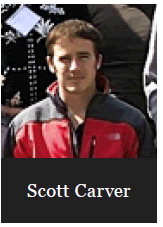
Rocky Mountain Virology Association 2011 attendees.
1. Natalia Voge, Colorado State University.
2. Sue VandeWoude, Colorado State University.
3. Britta Wood, Colorado State University.
4. Mauren Emanuelli, Colorado State University.
5. Brad Barrett, University of Colorado Denver Medical School.
6. Mario Santiago, University of Colorado Denver Medical School.
7. Sam Li, University of Colorado Denver Medical School.
8. Kejun Guo, University of Colorado Denver Medical School.
9. Joel Rovnak, Colorado State University.
10. Randall Cohrs, University of Colorado Denver Medical School.
11. Alex Griffith, Colorado State University.
12. Preston Neff, Colorado State University.
13. Stephanie Moon, Colorado State University.
14. Claire Birkenheuer Colorado State University.
15. Charles H. Calisher, Colorado State University.
16. Maria Nagel, University of Colorado Denver Medical School.
17. Carol D. Blair, Colorado State University.
18. Michael Harper, University of Colorado Denver Medical School.
19. Christopher Abraham, UC Denver.
20. Jeffrey Kieft, HHMI and University of Colorado Denver Medical School.
21. Wendy Sprague, Colorado State University.
22. Chaoping Chen, Colorado State University.
23. Bin Lu, Vivaldi Biosciences Inc.
24. Brian Foy, Colorado State University.
25. David Claypool, University of Colorado Denver Medical School.
26. Brian Geiss, Colorado State University.
27. Gregg Dean, Colorado State University.
28. Jeff Wilusz, Colorado State University.
29. Karl Heilman, University of Colorado Denver Medical School.
30. Justin Lee, Colorado State University.
31. Daniel Konet, Roche Applied Science.
32. Kalani Halemano, University of Colorado Denver Medical School.
33. April Rempel, University of Colorado Denver Medical School.
34. Scott Seitz, University of Colorado Denver Medical School.
35. Nathan Bos, University of Colorado Denver Medical School.
36. Igor Traktinskiy, University of Colorado Denver Medical School.
37. Scott Carver, Colorado State University.
38. Ryan Troyer, Colorado State University.
39. Kevin W. Diebel, University of Colorado School of Medicine.
40. Tony Schountz, University of Northern Colorado.
41. Sandra L. Quackenbush, Colorado State University.
42. Jennifer Arab, Colorado State University.
43. Jon LeCureux, Colorado State University.
44. Aaron T. Phillips, Colorado State University.
Translational medicine and virology are intimate partner on the road towards effective personal healthcare. A driving force for the development of more efficient high-throughput screening technologies is the search for more effective antivirus therapies. Perhaps the most promising ‘golden fleece’ of translational research is individual designer medicines synthesized from the patient’s own cells which have been removed and genetically altered before replacement. This technology has its beginnings in virology where gene transfer is easily accomplished and its ultimate success will be through advances in the field of virology where promoter modifications will drive the synthesis of specific proteins in both a time and cell dependent manner. With this in mind, it would benefit those interested in translational medicine to keep abreast of current topics in virology.
The 11th annual meeting of the Rocky Mountain Virology Association (RMVA) was held Sept. 23-25, 2011 at the forestry extension campus of Colorado State University (Pingree Park). RMVA (www.RockyMountainVirologyClub.org) began in 2001 as a regional gathering of virologists to share and discuss scientific data and ideas, and to provide a venue for graduate students to present their findings in a relaxed but professional setting. Since its inception, RMVA has attracted virologist from the Rocky Mountain area along with nationally and internationally recognized scientists, and has fostered interdisciplinary collaborations, assisted in grant development and has been the sounding board for multiple manuscripts. Autumn was selected to have the annual RMVA meeting coincide with the peak Aspen color change, and this year was not a disappointment. Herein a brief summary by the contributing author (identified by number in the figure) is presented.

1. Natalia Voge, Colorado State University presented a poster on innovative dengue diagnosis with metabolomics; some metabolites detected during the acute phase of the disease, are the direct product of the virus affecting the host cell metabolism. For this we are exploring the capacity of a metabolomics platform for the detection, characterization and profiling of metabolites that can be used as biomarkers for an early diagnosis in serum and non-invasive samples.

2. Sue VandeWoude, Colorado State University described a study conducted by Jesse Thompson et al evaluating elements of lentiviral virulence using a feline immunodeficiency virus model. A segment of the 3’ genome from a virulent strain (FIV-C36) was substituted on the backbone of a molecular clone of a less virulent isolate (FIV-PPR). This chimera demonstrated enhanced virulence relative to the apathogenic parental isolate. Serial passage of plasma resulted in a further increase in plasma viral load and immunopathology that approached that of the virulent parental strain. Primary in vivo infection was associated with a delay of several weeks of viral replication compared to either parental strain; this phenomenon was obscured during second passage, and was related to a specific mutation in the integrase portion of pol in the 5’ end of the gene. All cats in the second passage group were infected with a dominant viral species that contained a nonsynonymous substitution at this site.

3. Britta Wood, Colorado State University described (a) the development and validation of a MIA to simultaneously quantify domestic cat cytokines interferon-gamma, interleukin (IL)-10, and IL-12/ IL-23 p40 in plasma, (b) the extent to which plasma cytokines vary among domestic cats inoculated with host-adapted and/or non-host adapted feline immunodeficiency viruses, and (c) the comparison of cytokine concentrations to mRNA expression. We were able to determine plasma IL-12/IL-23 p40 levels in naïve and FIV infected cats, and show that mRNA cytokine expression in circulating PBMC may not equate to plasma levels.

4. Mauren Emanuelli, Colorado State University presented preliminary data on a novel vaccine strategy for feline immunodeficiency virus comprised of an antigen-receptor complex. It is described the antibody response in cats vaccinated with this complex in the context of different adjuvants and subsequently challenged with FIV-PPR viral stock. The next steps are to perform a large-scale vaccination trial and neutralization assays to determine the efficacy of the vaccine. This study has important potential implication for immunization against lentiviral disease in cats and other species, including humans.

5. Brad Barrett, UC Denver discussed the role of the Tetherin restriction factor in counteracting a pathogenic retrovirus infection in mice.

6. Mario Santiago, UC Denver summarized current evidence that a classical resistance gene known as Rfv3 is encoded by a deoxycytidine deaminase known as Apobec3. Apobec3 activity promotes the release of noninfectious virions that help drive the virus-specific neutralizing response directed against intact virus particles.

7. Sam Li, UC Denver provided data on the role of Ribonuclease L in counteracting a pathogenic gammaretrovirus in vivo.

8. Kejun Guo, UC Denver discussed the evolutionary implications of divergent viral restriction activities of the human versus rhesus monkey Apobec3A protein.

11. Alex Griffith, Colorado State University presented a poster describing population level exposure and pathogenic determinants of feline leukemia virus infection in Florida bobcats (Lynx rufus) and California mountain lions (Puma concolor). For these purposes, we compared and contrasted molecular (PCR) and serologic (SNAP®, Western Blot, and antibody capture ELISA) assays to identify the presence of FeLV provirus, viral protein production, and host humoral immune response against FeLV. To further characterize the origin of FeLV in free-ranging felines, we also performed phylogenetic analysis on DNA sequestered from infected animals. Observation of our data revealed disease susceptibility in pumas and bobcats similar to that seen in domestic animals, with overall seroprevalence exceeding antigenemia in both populations. Furthermore, genetically characterized provirus showed close homology with a robustly pathogenic strain of exogenous domestic cat FeLV. Results from this study suggest that domestic cats are a source of FeLV infection in both species of wild felids in North America, spanning multiple geographic locations.

13. Stephanie Moon, Colorado State University presented a talk entitled “Modulation of host mRNA stability by an RNA decay product of the Flavivirus genome”. Flaviviruses are positive sense, single stranded RNA viruses that replicate in the cytoplasm of mammalian and arthropod cells. The highly conserved secondary structure of the 3’ untranslated region of all arthropod-borne Flaviviruses stalls the host exoribonuclease XRN1 upon 5’ to 3’ decay of the viral genome, leading to the generation of short flavivirus RNA (sfRNA). sfRNA has been previously demonstrated to contribute to pathogenicity in Kunjin virus infected cells and in a mouse model. We hypothesize that sfRNA inhibits the major decay enzyme XRN1, which may play a role in pathogenesis. Here we show that Dengue virus sfRNA formation in mosquito and human cell extracts is associated with inhibition of XRN1-mediated decay of reporter transcripts. This finding is recapitulated using recombinant XRN1. Furthermore, Dengue virus and Kunjin virus sfRNA formation in infected cells in culture is associated with increased cellular transcript stability and the accumulation of uncapped mRNA decay intermediates. The formation of sfRNA during arthropod-borne flavivirus infections may constitute a novel mechanism for viral RNAs to influence host gene expression.

14. Claire Birkenheuer Colorado State University described the retroviral cyclin of walleye dermal sarcoma virus (WDSV), and explained its ability to increase transcript levels of the serum response genes, fos, EGR1 and jun. Rv-cyclin contains both a cyclin box and a transcriptional activation domain, and interacts with cyclin dependent kinase 8 (cdk8) and tata binding protein associated factor 9 (taf9) respectively. The data presented demonstrated rv-cyclin’s ability to activate the serum response genes. An activation as high as 65 fold was observed for these genes in the presence of rv-cyclin at 10hr post transfection when compared to the control. Additionally, rv-cyclin was shown to function during a genuine serum response in HCT116 cells that were stably expressing rv-cyclin. Furthermore, these experiments focused on the specific domain requirement for this activation, and showed that rv-cyclin requires binding of both partners for this enhancement.

15. Charles H. Calisher, Colorado State University presented two abstracts. The first abstract described the effect of diet on urinary pH of deer mice. Deer mice (Peromyscus maniculatus) are the principal rodent hosts of Sin Nombre virus, a causative agent of hantavirus pulmonary syndrome. During periods of drought, acquisition of virus by rodents decreases. When droughts end, even for brief periods, transmission resumes. Deer mice store dietary plant materials for future use and always have available invertebrates (ants, spiders, etc.), fungi and other potential food sources. Hantaan virus, the prototype hantavirus, is sensitive to low pH (<6.3), as are other viruses of the family Bunyaviridae. Hypothesis: lowered urinary pH inactivates virus being shed from the kidneys. We fed colonized adult deer mice lab chow, dried insects or kale; on day 20 mice fed insects were switched to kale and vice versa. Urinary pH of each mouse was tested each morning at 8 AM, from the day of arrival to the last day of the study. Mean urinary pH of deer mice fed laboratory chow remained relatively stable at pH 7.8-8.2; pH of mice fed kale were 7.6-8.4 but decreased precipitously when switched to insect diet; pH of mice fed insects decreased precipitously (6.2-6.4) on this diet and increased when switched to kale (7.5). Therefore, it is possible that when deer mice do not have vegetables available and switch to a diet comprising (mostly) insects that their urinary pH decreases and the infectious virus they are shedding from their kidneys becomes pH-inactivated. After a precipitation event occurs and the grasses grow, feeding on them allows the urinary pH to rise and excreted virus to be infectious.
The second abstract presented by Charles H. Calisher, Colorado State University initiated a new discussion format. The “Interesting things to think about” format presents ideas for general discussion. In this inaugural presentation, published evidence for the presence of viruses of numerous families was summarized. Virus or viral nucleic acid have been detected in fecal, oral, urine or fecal samples from bats, rodents, pigs and California sea lions. More than 100 viruses or viral nucleic acids have been detected in bats. Viral nucleic acids of the families Circoviridae, Picobirnaviridae, Picornaviridae, Astroviridae, Parvoviridae, Papillomaviridae, Adenoviridae, and Coronaviridae and of the families Densoviridae, Iridoviridae, Polydnaviridae, Dicistroviridae, Bromoviridae, Virgaviridae, Nanoviridae, Geminiviridae, Phycodnaviridae, Secoviridae, Partitiviridae, Tymoviridae, Alphaflexiviridae, and Tombusviridae (insect and plant viruses) have been detected in rodents, and of the families Picornaviridae, Astroviridae, Coronaviridae, Caliciviridae, Circoviridae and Parvoviridae in California sea lions. It was pointed out that increasing numbers of virus nucleic acids are being detected in a wide variety of domestic animals and wildlife and that the viruses themselves should be identified.

16. Maria A. Nagel, University of Colorado Denver School of Medicine presented a talk on VZV vasculopathy or stroke caused by virus infection of cerebral arteries. The cerebrovascular remodeling induced by VZV was discussed, including intimal thickening with myofibroblasts, apoptosis of the medial smooth muscle cells, and association of inflammatory cells with the thickened intima. All of these changes would lead to vascular occlusion, loss of contractility and ultimately stroke.

17. Carol D. Blair, Colorado State University described research by her former graduate student Bethany Bolling and other colleagues in which, during the course of testing mosquitoes collected in northern Colorado for West Nile virus (WNV) RNA, they discovered and isolated two insect-specific flaviviruses: Culex flavivirus (CxFV), which was first described from Japan, and a novel insect flavivirus, designated Calbertado virus (CLBOV), which has also been detected in California and Canada. In addition, quantitative RT-PCR revealed the presence of CxFV RNA in Culex pipiens eggs and larvae from a laboratory colony established in 2005 and naturally infected with CXFV. They used this colony to examine mechanisms of transmission of CxFV and effects of persistent CxFV infection on vector competence for WNV. They concluded that vertical transmission is the primary mechanism for viral persistence in the colony and that early stages of WNV replication in Culex pipiens mosquitoes might be suppressed by natural persistent CxFV infection.

18. Michael Harper, UC Denver discussed a potential effector mechanism for the antiretroviral activity of administered Interferon Alpha in vivo.

19. Christopher Abraham, UC Denver discusses current research describing a novel interaction between the epigenetic regulatory complex Polycomb repressive complex 2 (PRC2) and murine cytomegalovirus genomes. Using chromatin immunoprecipitation analysis, he reported observing enrichment of H3K27me3 at the major immediate-early (MIE) locus of MCMV very early following infection of permissive fibroblasts. As lytic replication progressed, he observed a loss of H3K27me3 enrichment concomitant with the appearance of H3K4me3. However, late during infection, as viral replication centers are established, he observed a significant increase in PRC2 association with chromatin. Additionally, co-immunofluorescence assays using confocal microscopy, detected strong enrichment for PRC2 components within the viral replication compartment, suggesting an association between viral DNA synthesis machinery and Polycomb.

20. Jeffrey Kieft, University of Colorado Denver School of Medicine presented a talk outlining recent discoveries of how the Hepatitis C Virus Internal Ribosome Entry Site (HCV IRES) RNA manipulates host cell ribosomes to drive translation of the viral proteins. A recent publication from the Kieft Lab revealed that a specific RNA structural domain of the IRES has the ability to alter the configuration of the viral RNA that is placed in the ribosome’s decoding groove, and this affects the ability of the IRES to start protein synthesis. Building on this work, and using structural probing, modeling of atomic resolution structures of ribosome-IRES complexes, and other functional assays, the Kieft Lab has discovered novel effects of mutating this domain that appear to be focuses on the interaction of the IRES with a single, highly conserved ribosomal protein.

21. Wendy Sprague, Colorado State University, presented a synopsis on her research in the VandeWoude lab identifying cells infected with feline immunodeficiency virus during in vitro infection of activated PBMC. She also showed differences in phenotypic expression of cells from infected and uninfected cultures. Highlights of the study demonstrate that approximately 1/3 of the CD4+ cells were infected, however, most of the infected did not express CD4, CD8 or B220. All cells expressed FAS in both infected and uninfected cultures, and CD134 and CD4 expression were decreased in cells from infected versus uninfected cells. In addition, CD8 cells expressing interferon gamma were decreased in the cells from infected cultures versus uninfected cultures.

22. Chaoping Chen, Colorado State University described HIV protease autoprocessing which is a regulated process by which the protease domain embedded in the Gag-Pol polyprotein precursor catalyzes the essential cleavage reactions that liberate free mature protease. We previously described an assay using a fusion precursor, consisting of the mature protease (PR) along with its upstream transframe region (p6*) sandwiched between GST and a small peptide epitope, to examine the autoprocessing reactions in transfected cells. We here demonstrated that the precursor proteases were much less sensitive than the mature protease to inhibition by protease inhibitors Darunavir and Indinavir, suggesting existence of different catalytic site conformations in these two forms of proteases. The cell-based autoprocessing assay also provides a sensitive tool for functional screening of novel autoprocessing inhibitors that suppress HIV protease activity via mechanisms distinct from the current catalytic site inhibitors.

23. Bin Lu, Vivaldi Biosciences Inc outlined the significant public health problem caused by influenza virus, and discussed the application of Vivaldi’s NS1 (nonstructural protein 1) biology platform to develop live attenuated influenza vaccines (LAIVs). This proprietary technology employs genetic modification of NS1 to attenuate the virus and generate LAIVs that confer a robust immune response through intranasal administration. NS1-attenuated LAIVs are “self-adjuvanted” by stimulating local production of interferon, which enhances immune recognition. Preclinical studies demonstrate that NS1-attenuated LAIVs provide a potent protection again matched strains and cross-protection against mismatched strains. Vivaldi’s technologies enable a rapid response to the frequent changes that occur in seasonal influenza viruses and emerging pandemic strains.

24. Brian D. Foy, Colorado State University presented the results of a study published by him and his colleagues in Emerging Infectious Diseases about an unusual cluster of cases of persons who became sick with Zika virus disease in northern Colorado in 2008. The subjects of the case study were in fact Foy, his graduate student, and his wife. The results suggest that Foy and his graduate student contracted Zika virus in southeastern Senegal from infectious mosquito bites while working on a malaria project in villages of the area. Both became sick soon after they returned home to Fort Collins. Their symptoms (maculopapular rash, headache, arthralgia in their joints) were suggestive of an arboviral disease and serological analysis of paired acute and convalescent sera revealed that they developed an anamnestic response against Zika virus, likely due to their prior vaccination with the yellow fever virus vaccine. Foy’s wife became ill with almost the identical symptoms within a week after her husband became ill. Serological analysis revealed that she contracted a primary Zika virus infection. Evidence was presented that suggest direct, likely sexual transmission of Zika virus occurred between he and his wife. Furthermore, the epidemiology of a large outbreak of Zika virus disease on Yap Island in 2007 is suggestive that sexual transmission of Zika virus may also have occurred there. Further research on the possible sexual transmission and unique pathology of Zika virus is planned.

26. Brian Geiss, Colorado State University presented a talk about the mechanisms of RNA capping by flaviviruses (dengue, West Nile, ect.) and the efforts underway to develop now antiviral drugs that interfere with the process. Our laboratory has studied the novel flavivirus RNA capping enzyme located in the NS5 N-terminal methyltransferase domain. RNA guanylyltransferase activity was recently identified by our group in the methyltransferase domain that transfers a GMP molecule to a diphosphorylated RNA acceptor molecule, forming the 5’ RNA cap structure. Ongoing efforts to understand the mechanism of NS5 guanylyltransferase function were discussed. In addition, a new antiviral molecule that was identified from a high-throughput screening campaign targeting the NS5 guanylyltransferase enzyme was presented and discussed.

27. Gregg Dean, Colorado State University described the role of natural killer (NK) cells in the pathogenesis and prevention of HIV-1. Using the feline immunodeficiency model of HIV-1 in people, regulatory T cells were depleted then cats were challenged with subcutaneous Listeria monocytogenes (Lm). The innate immune response to Lm was assessed and revealed that NK cells failed to migrate to the draining lymph node, proliferated at a low rate, showed increased apoptosis, and expressed low levels of perforin. A mathematical model of acute HIV-1 infection in the mucosa was described that predicts dendritic cell activation accelerates the spread of virus while NK cells can dramatically reduce the replication and spread of virus. Evidence suggesting antibody mediated cellular toxicity mediated through NK cells could be an important correlate of vaccine protection was presented and a strategy to use recombinant Lactobacillus spp. as a vaccine vector to accomplish this was described.

29. Karl Heilman, UC Denver presented data on which IgG subclasses correlate with the protective retrovirus-specific neutralizing antibody response due to the Apobec3/Rfv3 gene.

31. Daniel Konet, Roche Applied Science presented the basics involved in Chromosomal Immunoprecipitation assays. ChIP is one of the most widely used techniques to analyze protein/DNA complexes. My talk described the basic technique and major pitfalls encountered in typical ChIP assays.

32. Kalani Halemano, UC Denver outlined specific steps in B cell development that are affected by the Apobec3/Rfv3 gene during pathogenic Friend retrovirus infection of mice.

33. April Rempel, University of Colorado Denver Medical School showed the presence of VZV antigen in the arteries of diabetic patients. Arteries of patients without any signs of VZV vasculopathy were run through an RT-PCR to test for presence of VZV gene 63. Arteries containing the gene were then analyzed histochemically for VZV Antigen and CD45. Noncontiguous sections of artery containing the VZV antigen were found to also be associated with cell expressing CD45. This points to the need to consider VZV Vasculopathy as another cause of strokes in diabetic patients.

34. Scott Seitz, UC Denver discussed the stability of acyclovir in space. Varicella zoster virus (VZV) can reactivate from latency in astronauts during short term spaceflight. Acyclovir is an effective antiherpesvirus drug targeting virus DNA replication, but the stability of acyclovir stored in space has not been determined. Using herpes simplex virus type 1 plaque reduction assays, the EC50 of acyclovir stored on the International Space Station was compared to the same drug lot stored for the same time n earth was compared to the EC50 of newly obtained (pharmacy grade) acyclovir. The results show space exposure may contribute to a loss of efficacy in acyclovir.

36. Igor Traktinskiy, UC Denver described varicella zoster virus infection of cerebrovascular adventitial fibroblasts. Analysis of VZV-infected primary cerebrovascular fibroblasts using primers specific transcripts known to be involved in vascular remodeling show that cells acquire proinflammatory and antiviral phenotype. Specifically, upregulation and secretion of interleukin-8 in the supernatant of the cultured cells show recruitment of neutrophils. The relevance of findings was then compared to VZV infected cerebral artery from subject with VZV vasculopathy and demonstrated IL8 and neutrophils presents. The findings suggest that VZV-infected primary cerebrovascular adventitial fibroblasts are a feasible model for studying the pathogenesis of VZV vasculopathy.

37. Scott Carver, Colorado State University introduced us to Urbanization and pathogen exposure in sympatric populations of wild and domestic felids. We describe how there is sympatry between wild and domestic felids around urbanizing areas in the U.S. We detail how this sympatry may lead to interspecific interactions and cross-species transmission of pathogens shared by puma, bobcat and domestic cat. We also detail how land-use variables, particularly urbanization, may predict degree of contact and disease transmission between wild and domestic felids. By using land-use variables associated with wild and domestic felid capture locations we evaluated the determinants of pathogen exposure in wild and domestic felids. We evaluated exposure (detectable antibody) to four pathogens; Feline Immunodeficiency virus, Feline Calicivirus, Feline Herpes virus, Feline Panleukopenia virus. We initially determined species (age and sex) and location (county) determinants of exposure. We then examined whether the fit of species and location models could be improved by adding land-use variables. Preliminary analyses indicate that elements of urbanization may define exposure of wild and domestic felids to some pathogens.

38. Ryan Troyer, Colorado State University presented data on the role of the accessory genes Vif and OrfA in feline immunodeficiency virus (FIV) replication. Chimeric viruses were generated which express the Vif and/or OrfA genes of the highly pathogenic molecular clone FIV-C36 in the backbone of the relatively avirulent FIV-PPR. Clones expressing the FIV-C36 Vif gene replicated similarly in vitro to FIV-C36 rather than the parental FIV-PPR, suggesting that Vif plays a major role in determining FIV replication capacity. A virus expressing the FIV-C36 OrfA replicated more rapidly in vitro than the parental FIV-PPR, suggesting that OrfA has a moderate effect on FIV replication capacity.

39. Kevin W. Diebel, University of Colorado School of Medicine described novel biogenesis pathways used by gammaherpesvirus 68 to produce biologically functional miRNAs. Biogenesis of microRNAs (miRNAs) using the canonical transcription and processing pathway begins by transcribing a primary-microRNA (pri-miRNA) transcript using RNA polymerase II (pol II) followed by sequential cleavage of the pri-miRNA using the endonucleases Drosha and Dicer to generate a ~22 nucleotide long, maturely processed miRNA. Currently, a growing body of evidence is emerging that suggests a significant portion of biologically functional miRNAs can be produced through noncanonical transcription and processing pathways. The production of biologically functional miRNAs from Gammaherpesvirus 68 (γHV68) is representative of one such alternative transcription and processing pathway. Recent work has shown that the transcription of pri-miRNA transcripts from γHV68 is conducted through the use of RNA polymerase III (pol III) to produce biologically functional miRNAs during lytic infection from previously uncharacterized RNA pol III type 2-like promoters. These γHV68 pol III transcripts contain a 5’ tRNA-like domain immediately upstream to the precursor-miRNA (premiRNA) stem-loops. Here we demonstrate that the maturation of γHV68 miRNAs is dependent upon the enzymatic activity of the tRNA processing enzyme RNaseZL. Additionally, we demonstrate that the unusual RNA pol III type 2-like promoter sequences are required in their entirety to initiate transcription of the pri-miRNA transcripts and that the RNA polymerase III type 2-like promoter is located in genomes across all three domains of cellular life. In total, both the transcription and processing of the γHV68 miRNAs demonstrates an alternate means of miRNA generation that exemplifies integration of noncanonical miRNA processing with the production of biologically functional miRNAs.

40. Tony Schountz, University of Northern Colorado described efforts characterizing the transition immune responses during acute to persistent infection of deer mice (Peromyscus maniculatus) infected with Sin Nombre virus. Two days post infection most genes examined were repressed in the lungs and spleens. However two inflammatory chemokines, Ccl2 and Ccl5 were elevated in the spleens. At 5 days post infection other inflammatory innate genes were elevated and a T cell response appeared to occur on days 7 and 10, after which they subsided. On days 15 and 20 post infection, expression of TGFb was elevated while inflammatory genes were repressed, suggesting that inflammatory response gave way to a regulatory-like anti-inflammatory response. This transition may explain the lack of disease in deer mice and why they are unable to clear the virus and remain persistently infected.

44. Aaron T. Phillips, Colorado State University described his studies using an infectious clone of Western equine encephalitis virus McMillan strain, a highly neurovirulent in mice, that was engineered to express a transgene under the control of a 3’ double subgenomic promoter. Constructs included firefly luciferase (LUC), DsRed, and GAL4-expressing variants. Outbred CD-1 mice were used with LUC and DsRed –expressing variants and Tg UAS-LUC were used with the GAL4 –expressing variant. This system was used to show that virus dissemination may occur through neuronal connectivity in the case of intranasal challenge and descriptions of the resulting pathogenesis were presented through histological examination. Variations in neuroinvasion patterns were shown between olfactory and peripheral inoculations. Dsred-expressing virus was used to demonstrate viral replication at the cellular level using microscopy. Focal concentrations of fluorophore along neuronal the processes were found. To validate this system as a convenient proxy of antiviral efficacy, mice were treated with liposome-associated-nucleic acid-antigen-complex based on the WEEV-E1 ectodomain and infected with LUC-expressing virus. The results demonstrate excellent antiviral assessment as treated animals survived and showed minimal luminescence while untreated animal did not survive and showed very high levels of luciferase expression.
2529








































